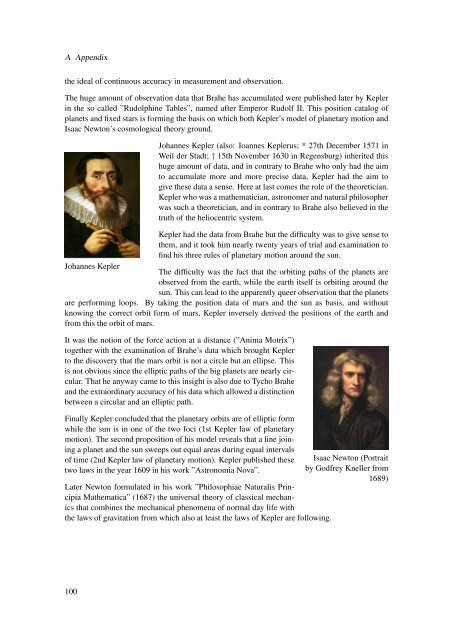Diffusion Processes with Hidden States from ... - FU Berlin, FB MI
Diffusion Processes with Hidden States from ... - FU Berlin, FB MI
Diffusion Processes with Hidden States from ... - FU Berlin, FB MI
You also want an ePaper? Increase the reach of your titles
YUMPU automatically turns print PDFs into web optimized ePapers that Google loves.
A Appendixthe ideal of continuous accuracy in measurement and observation.The huge amount of observation data that Brahe has accumulated were published later by Keplerin the so called ”Rudolphine Tables”, named after Emperor Rudolf II. This position catalog ofplanets and fixed stars is forming the basis on which both Kepler’s model of planetary motion andIsaac Newton’s cosmological theory ground.Johannes Kepler (also: Ioannes Keplerus; * 27th December 1571 inWeil der Stadt; † 15th November 1630 in Regensburg) inherited thishuge amount of data, and in contrary to Brahe who only had the aimto accumulate more and more precise data, Kepler had the aim togive these data a sense. Here at last comes the role of the theoretician.Kepler who was a mathematician, astronomer and natural philosopherwas such a theoretician, and in contrary to Brahe also believed in thetruth of the heliocentric system.Kepler had the data <strong>from</strong> Brahe but the difficulty was to give sense tothem, and it took him nearly twenty years of trial and examination tofind his three rules of planetary motion around the sun.Johannes KeplerThe difficulty was the fact that the orbiting paths of the planets areobserved <strong>from</strong> the earth, while the earth itself is orbiting around thesun. This can lead to the apparently queer observation that the planetsare performing loops. By taking the position data of mars and the sun as basis, and <strong>with</strong>outknowing the correct orbit form of mars, Kepler inversely derived the positions of the earth and<strong>from</strong> this the orbit of mars.It was the notion of the force action at a distance (”Anima Motrix”)together <strong>with</strong> the examination of Brahe’s data which brought Keplerto the discovery that the mars orbit is not a circle but an ellipse. Thisis not obvious since the elliptic paths of the big planets are nearly circular.That he anyway came to this insight is also due to Tycho Braheand the extraordinary accuracy of his data which allowed a distinctionbetween a circular and an elliptic path.Finally Kepler concluded that the planetary orbits are of elliptic formwhile the sun is in one of the two foci (1st Kepler law of planetarymotion). The second proposition of his model reveals that a line joininga planet and the sun sweeps out equal areas during equal intervalsof time (2nd Kepler law of planetary motion). Kepler published thesetwo laws in the year 1609 in his work ”Astronomia Nova”.Later Newton formulated in his work ”Philosophiae Naturalis PrincipiaMathematica” (1687) the universal theory of classical mechanicsthat combines the mechanical phenomena of normal day life <strong>with</strong>the laws of gravitation <strong>from</strong> which also at least the laws of Kepler are following.Isaac Newton (Portraitby Godfrey Kneller <strong>from</strong>1689)100









